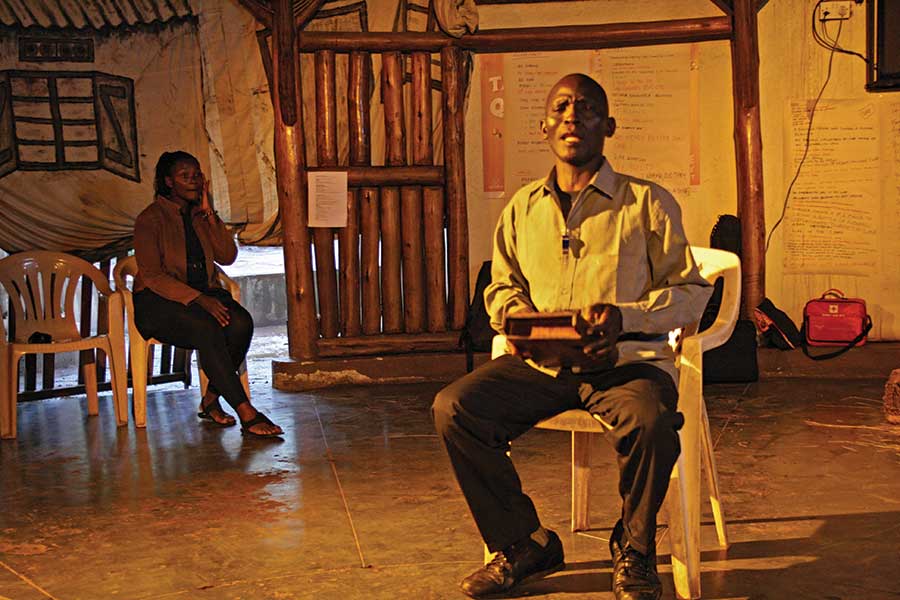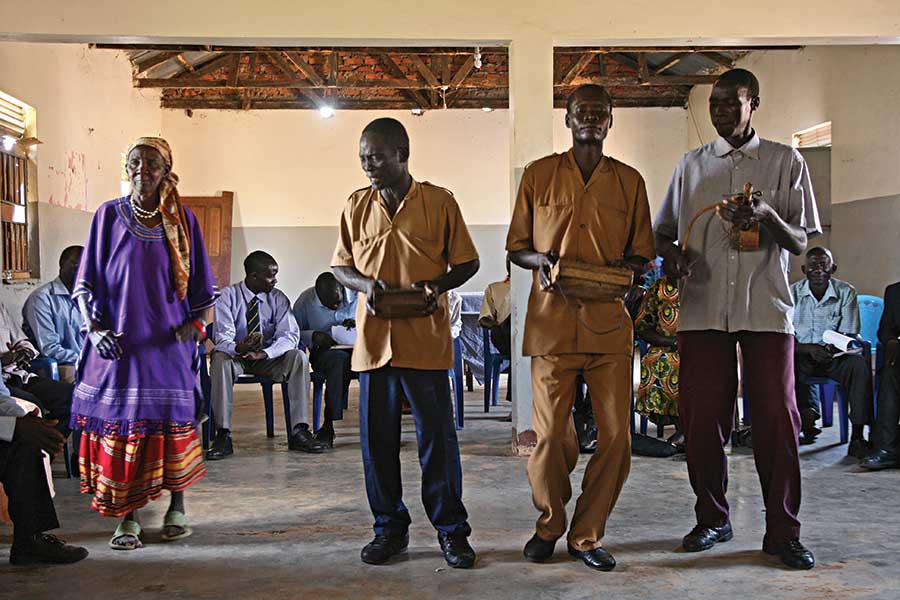Perhaps we should hire security,” suggests Okweny George Ongom, coproducer of the project I’m working on with a team of theatre artists in the East-Central African nation of Uganda in October 2015. The idea is prompted by news of a recent armed robbery near Ongom’s home community far to the north of Kampala, the capital. An armed guard might be a wise idea during our time in the north, agrees another colleague, Kampala-based coproducer Alberto Mubiru. I ask myself: What am I doing here?
Then our rented Toyota van blows a head gasket, stranding us in a remote village by a dusty road. What were we thinking?
During our preparatory workshop at the Uganda National Cultural Centre in bustling Kampala, my collaborators help me understand that with 52 languages in 7 language groups, Uganda is a multicultural country—small, yet only tenuously united. The possibility of misunderstanding is real, and consequences could be dire. Alone in my comfortable hotel that night, I wonder, as a white, middle-aged American theatremaker far from home: Do I have anything useful to offer? And even if I do, how might that transaction happen without reinforcing or perpetuating colonialist paradigms? Anyway, what can we accomplish in only three weeks? Am I painfully naïve? Arrogantly overconfident? Completely insane?
Three days later, assembled in a community Story Circle in the northern village of Aloi in the rural Alebtong District, we listen as a young Lango man describes his abduction by the Lord’s Resistance Army, or LRA. He was a child then. He was commanded to watch—eyes open and without tears—as his stepmother was beaten to death. That was his initiation.
Ongom translates the young man’s Luo into English. In the silence that follows, we all remember exactly why we are here: to witness, to listen, to share, and to work together to make art that pays attention. We hold one another. The young man expresses gratitude that we have listened, and other stories flow. A song begins.
Soon the circle is dancing, weeping, and even laughing.
I have returned to Uganda at the invitation of Ongom and Mubiru for a project called “Langi Voices.” The three of us had met four years prior, when I’d come to East Africa as part of a team traveling with playwright Erik Ehn. “This happy meeting,” says Ehn of the project, “is an outcome of the Arts in the One World initiative, a series of curated, reciprocal conversations centered on the exploration of arts for social change, and the efficacy and methods of witness.” For 10 years, on both sides of the ocean, Ehn and his partners have met at conferences and seminars—and, Ehn adds, “at soccer games, dances around fires, long bus rides, meals together.”
“Our work in East Africa generally centered on annual group visits to Rwanda and Uganda, for three weeks at a stretch,” Ehn continues. “We never arrived with a particular project or outcome in mind—we came in need, to learn, chiefly through waiting and listening, receiving wisdom and experience, attending to opportunities for connection.”
Mubiru, a multifaceted theatre director and dance producer, handled logistics for that 2011 journey, my first (but Ehn’s eighth); Ongom, executive director of A River Blue (ARB), a comprehensive community-development effort serving the Lango people, hosted the cohort that year in the Alebtong District.
The United Nations estimates that 66,000 children were abducted during the 20 years of war in northern Uganda. The victims were mostly Acholi and Lango. Joseph Kony’s infamous LRA murdered many outright, transforming the rest into child soldiers, sex slaves, or laborers, in pursuit of his goal of purportedly making the world comply with the Ten Commandments. Remaining families sought protection in internally displaced persons camps, where cultural knowledge faded; families dependent for decades on food distributed from aid trucks forgot how to farm.
The LRA war ended here around 2008, leaving shattered social structures. How to reintegrate the formerly abducted? Now young adults, they had escaped the LRA and come home, but had wielded automatic weapons against their own people. “Soldier-wives” brought with them children fathered by their hated captors. No family was unaffected. What tools did Ongom’s ARB initiative use first to mend this torn society?
Dance, song, poetry, performance—it is the way of the Lango to make arts central to their quest for social healing, essentially coequal with water projects, nutrition, health care, and vocational education. This is astonishing from an American perspective, but it is a reality in Uganda.
At the 2011 gathering, Mubiru listened to Lango testimonies and was deeply moved. He considered himself well informed, yet these personal stories came to him as revelation. One night, around a campfire, Mubiru made a tearful apology and a personal promise: He would seek ways to share these stories with other Ugandans, across considerable linguistic, cultural, and political barriers.
“George [Ongom] realized that while traditional arts had helped reweave his community,” Mubiru explains, “perhaps the stories weren’t traveling well. How could we get them heard outside of Alebtong District? George and I put together a five-year plan, which included using music, dance, and dramatic storytelling for social change and healing of the people.”
The plan also led to an invitation for me, and when Ongom visited the U.S., I helped him craft his testimony for church and university audiences. Ongom, in turn, invited me to bring these methodologies to Uganda. A Theatre Communications Group Global Connections In the Lab grant (funded by the Andrew W. Mellon Foundation and the Robert Sterling Clark Foundation), a Network of Ensemble Theaters NET/TEN Travel Grant, and individual gifts made Langi Voices possible.

I’ve worked with diverse and distressed off-the-radar communities in rural Pennsylvania, Appalachia, and the Deep South, creating original story-plays that address intractable issues and inspire positive change. But no project has been more daunting than this venture in Uganda. Through what I’d learned working alongside the late playwright/poet Jo Carson, incorporating the story-circle process pioneered by American theatre and Civil Rights icon John O’Neal, I had a toolkit to help communities frame their stories in ways that open healing opportunities. I’ve come to call this toolkit “Story Work.”
Mubiru brought together our Kampala-based actors: two women, Allen Kagusuru and Esther Tebandeke, and one man, Tonny Muwangala. This was great news; not only is each highly regarded in Ugandan theatre, TV, and film, but they also share a long collaborative history. I’ve also known these actors since 2011, and enjoyed their performances at New York’s La MaMa and with ArtSpot Productions in New Orleans. “Over the past five years,” explains Mendelsohn, “we’ve used the process of developing two productions—Deborah Asiimwe’s Cooking Oil and Erik Ehn’s Maria Kizito—as a lab to explore joint aesthetics rooted in contemporary ritual and oral storytelling.” Having these artists on board for Langi Voices felt like something of a miracle.
Muwangala took time away from producing news at NTV, Uganda’s national television; Tebandeke had just completed a film for Disney, working with Lupita Nyong’o and David Oyelowo on Queen of Katwe, to be released in 2016. “What attracted me to this project was the opportunity to listen and learn how to turn simple stories told by ordinary people into exciting scripts,” says Tebandeke.
Meanwhile, Ongom had assembled 30 Langi willing to share their stories, and two virtuoso composer/musicians: Onyung James (on Bule, also known as Langi Talking Drum) and Okut Tony (on Okeme, also known as Thumb Piano). Production assistant and documentarian Jashon Tusingwire rounded out this fun, hard-working, indomitable team.
We workshop the Story Work process at the Uganda National Cultural Center in Kampala, exploring its core values of agency, authenticity, artistry, accuracy, and audacity. “No questions? No crosstalk? This was entirely new to Ugandans!” jokes Muwangala when we’re done. Then it’s north to Aloi, to meet our Langi partners, to sing and dance and play theatre games with them, and to listen, through facilitated Story Circles.
There, reports Tebandeke, “The community was so warm and open to anything we threw at them, and the music they offered was the icing on the cake. Telling stories through music was so alive, and it made the sadder or darker stories easier to digest. I could feel that those who were sad came to these circles looking to be heard, and to find salvation. It was humbling for me to listen. We all need to be heard, to be considered, to be given attention.”
In a hotel courtyard in Lira we devise our play. The actors select their stories. We sing in Luo but speak in English, Uganda’s national language, which is widely used in Kampala. Our two musicians speak little English; Ongom provides translation. Now and then, the hotel staff join in the songs and games, delighted to see their traditions validated.
Our story play, Alebtong (working title), contains nine stories, four songs, four dances, and a couple of Lango children’s games. Hard stories of violence, abduction, and displacement are balanced alongside tales of humor and grace—stories of a wizard in the woods, of a romantic triangle, of a mother who encourages her daughter to become educated while stubbornly refusing her permission to marry. One is even about a proud young man whose proof of his popularity is generating a syphilis epidemic. The performance at Kampala’s UNCC, reportedly unlike anything seen there before, is enthusiastically embraced.
Still, the show isn’t the point; this intensive was intended more as a provocation, an offer of concrete tools that must now draw on the abundant skills of Ugandans. “We came to know that we can make Langi stories cross boundaries—it was the first experience of its kind in my lifetime,” exclaims Ongom. “Our audience understood all the versions of the stories very quickly, and discovered a new approach to entertainment. I propose,” he goes on, “that ARB build the capacity to make a curriculum to teach its students, then form a consortium of all the tribes in Uganda, to share stories and take them all around Uganda and beyond.”
Actor Kagusuru also counts herself filled with hope. “This is a method that can move mountains in many different parts of my country that need healing,” she says. “It can bridge the gulf between people and create a better world of oneness.”
In the wake of our visit, Kagusuru, Muwangala, and Tebandeke continue to work with director Mendelsohn as part of Waypoints Ensemble. “Our next project,” reports Mendelsohn, “is a meditation on home, with two parallel journeys through Kampala and San Francisco. We’re looking at what ‘global stage’ means to us—not as a center of power, but as a space of active negotiation across distance.”
From my perspective, we have delivered on our modest promise. Ehn puts it this way: “Over time, some few folks who took part in convenings in the States or in East Africa have gone on to write articles, make movies, run programs, share performances, commission workshops, and more.”
The key word is “more.”
Gerard Stropnicky cofounded the Network of Ensemble Theaters, as well as Bloomsburg Theatre Ensemble, where he is member emeritus. He is based in rural Danville, Pa.


